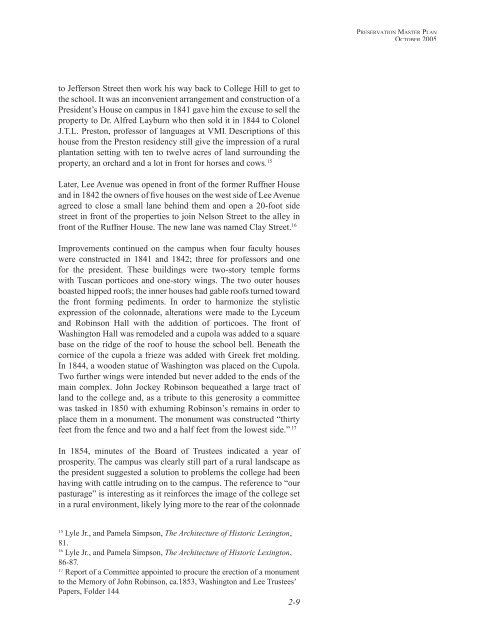A BRIEF HISTORY OF WASHINGTON AND LEE - Society for ...
A BRIEF HISTORY OF WASHINGTON AND LEE - Society for ...
A BRIEF HISTORY OF WASHINGTON AND LEE - Society for ...
You also want an ePaper? Increase the reach of your titles
YUMPU automatically turns print PDFs into web optimized ePapers that Google loves.
PRESERVATION MASTER PLANOCTOBER 2005to Jefferson Street then work his way back to College Hill to get tothe school. It was an inconvenient arrangement and construction of aPresident’s House on campus in 1841 gave him the excuse to sell theproperty to Dr. Alfred Layburn who then sold it in 1844 to ColonelJ.T.L. Preston, professor of languages at VMI. Descriptions of thishouse from the Preston residency still give the impression of a ruralplantation setting with ten to twelve acres of land surrounding theproperty, an orchard and a lot in front <strong>for</strong> horses and cows. 15Later, Lee Avenue was opened in front of the <strong>for</strong>mer Ruffner Houseand in 1842 the owners of five houses on the west side of Lee Avenueagreed to close a small lane behind them and open a 20-foot sidestreet in front of the properties to join Nelson Street to the alley infront of the Ruffner House. The new lane was named Clay Street. 16Improvements continued on the campus when four faculty houseswere constructed in 1841 and 1842; three <strong>for</strong> professors and one<strong>for</strong> the president. These buildings were two-story temple <strong>for</strong>mswith Tuscan porticoes and one-story wings. The two outer housesboasted hipped roofs; the inner houses had gable roofs turned towardthe front <strong>for</strong>ming pediments. In order to harmonize the stylisticexpression of the colonnade, alterations were made to the Lyceumand Robinson Hall with the addition of porticoes. The front ofWashington Hall was remodeled and a cupola was added to a squarebase on the ridge of the roof to house the school bell. Beneath thecornice of the cupola a frieze was added with Greek fret molding.In 1844, a wooden statue of Washington was placed on the Cupola.Two further wings were intended but never added to the ends of themain complex. John Jockey Robinson bequeathed a large tract ofland to the college and, as a tribute to this generosity a committeewas tasked in 1850 with exhuming Robinson’s remains in order toplace them in a monument. The monument was constructed “thirtyfeet from the fence and two and a half feet from the lowest side.” 17In 1854, minutes of the Board of Trustees indicated a year ofprosperity. The campus was clearly still part of a rural landscape asthe president suggested a solution to problems the college had beenhaving with cattle intruding on to the campus. The reference to “ourpasturage” is interesting as it rein<strong>for</strong>ces the image of the college setin a rural environment, likely lying more to the rear of the colonnade15Lyle Jr., and Pamela Simpson, The Architecture of Historic Lexington,81.16Lyle Jr., and Pamela Simpson, The Architecture of Historic Lexington,86-87.17Report of a Committee appointed to procure the erection of a monumentto the Memory of John Robinson, ca.1853, Washington and Lee Trustees’Papers, Folder 144.2-9
















